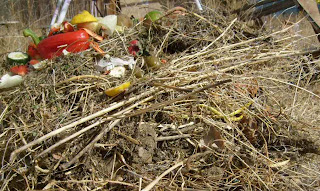So...I've always been a composter, and that's probably thanks to my grandma and grandpa. Their farm was huge, and all the vegetables they ate were grown by hand (no machines or grocery stores). It was impressive. I remember my grandma putting vegetable scraps in a jug that she'd carry over to the large garden area (although she often gave them to her chickens too), and I also remember grandpa putting corn stalks in a pile for composting, along with other vegetable matter. What a great garden that was. What was cool was their land--between the chickens (plus their eggs), the cows (plus their milk), their vegetables and fruits, and wild game--fully sustained them. I know my grandma bought sugar, coffee, and flour, but even then, I'm sure their earnings from making Christmas wreaths and selling firewood allowed them those amenities.
Anyway, back to composting...I started composting on my own right after I got married. I became active in environmentalism and realized that I could send less trash to the landfill if I composted all vegetable scraps. I've gotten better at my techniques over the years, but I really like the Biointensive way of doing it.
Your bottom layer is comprised of sticks and twigs, because they allow the air to circulate. Then you have a layer of brown (mature dead vegetation) and then green (fresh grass trimmings, garden clippings, and kitchen scraps--immature). Then you have a thin layer of dirt (which contains the microbes that will cook the compost into humus). I'll keep adding to this pile, layer by layer, until it's about four feet high (although it's already starting to compress). It's under a tree, which is recommended by this method as well. I won't use the compost from this pile until probably next year, but I'll start a new pile once this one gets big. I won't turn it or anything. Again, that's because Biointensive advocates mimicking nature as much as possible. Turning the pile would make it compost faster, but I would end up with less carbon in the compost, so it's better to let nature take its course.
If you're interested in Biointensive gardening, their website is at Ecology Action. If you're interested in these techniques, you can buy the book How to Grow More Vegetables by John Jeavons, which is what I'm basing all my gardening on this year. I can't wait to see how this year's garden compares to those of the past.

No comments:
Post a Comment